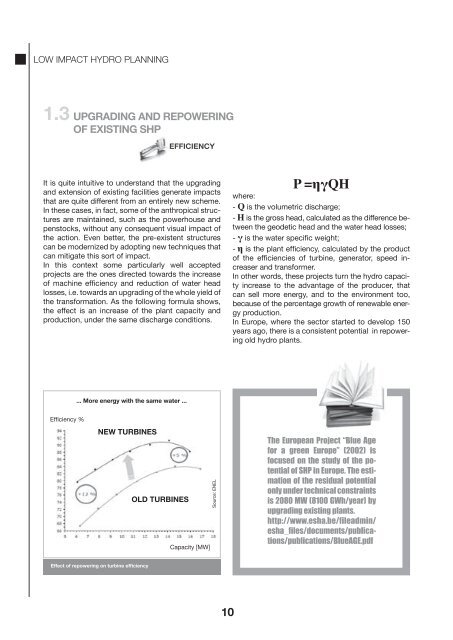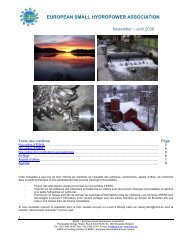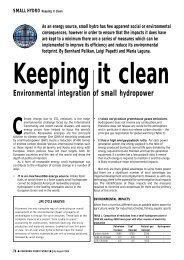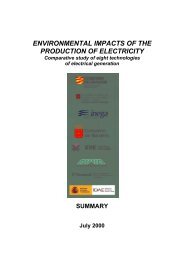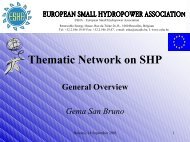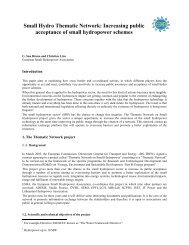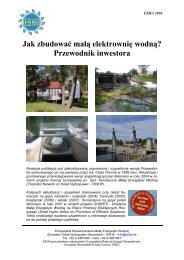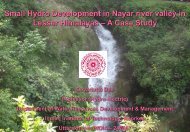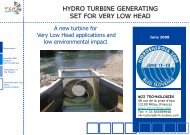HYDROPOWER AND ENVIRONMENT - ESHA
HYDROPOWER AND ENVIRONMENT - ESHA
HYDROPOWER AND ENVIRONMENT - ESHA
You also want an ePaper? Increase the reach of your titles
YUMPU automatically turns print PDFs into web optimized ePapers that Google loves.
LOW IMPACT HYDRO PLANNING<br />
1.3<br />
UPGRADING <strong>AND</strong> REPOWERING<br />
OF EXISTING SHP<br />
EFFICIENCY<br />
It is quite intuitive to understand that the upgrading<br />
and extension of existing facilities generate impacts<br />
that are quite different from an entirely new scheme.<br />
In these cases, in fact, some of the anthropical structures<br />
are maintained, such as the powerhouse and<br />
penstocks, without any consequent visual impact of<br />
the action. Even better, the pre-existent structures<br />
can be modernized by adopting new techniques that<br />
can mitigate this sort of impact.<br />
In this context some particularly well accepted<br />
projects are the ones directed towards the increase<br />
of machine effi ciency and reduction of water head<br />
losses, i.e. towards an upgrading of the whole yield of<br />
the transformation. As the following formula shows,<br />
the effect is an increase of the plant capacity and<br />
production, under the same discharge conditions.<br />
Effi ciency %<br />
... More energy with the same water ...<br />
NEW TURBINES<br />
Effect of repowering on turbine effi ciency<br />
OLD TURBINES<br />
Capacity [MW]<br />
Source: ENEL<br />
10<br />
P =ηγQH<br />
where:<br />
- Q is the volumetric discharge;<br />
- H is the gross head, calculated as the difference between<br />
the geodetic head and the water head losses;<br />
- γ is the water specifi c weight;<br />
- η is the plant effi ciency, calculated by the product<br />
of the effi ciencies of turbine, generator, speed increaser<br />
and transformer.<br />
In other words, these projects turn the hydro capacity<br />
increase to the advantage of the producer, that<br />
can sell more energy, and to the environment too,<br />
because of the percentage growth of renewable energy<br />
production.<br />
In Europe, where the sector started to develop 150<br />
years ago, there is a consistent potential in repowering<br />
old hydro plants.<br />
The European Project “Blue Age<br />
for a green Europe” (2002) is<br />
focused on the study of the potential<br />
of SHP in Europe. The estimation<br />
of the residual potential<br />
only under technical constraints<br />
is 2080 MW (8100 GWh/year) by<br />
upgrading existing plants.<br />
http://www.esha.be/fileadmin/<br />
esha_fi les/documents/publications/publications/BlueAGE.pdf


